A Short History of Tendai Buddhism
The Tendai School of Buddhism is one of the most important sects of Japanese Buddhism, established in the 8th Century CE. Its origins are firmly rooted in both the Dharma taught by Shakyamuni Buddha – the historical Buddha – as well as the Mahayana school of Buddhism and China’s T’ien-t’ai Buddhist doctrine. Named after the sacred mountain in southeast China and popularized by the philosopher, teacher and practitioner Chih-i (538-597) and the Japanese monk Saicho (767-822), the Tendai school gave rise to other important schools of Japanese Buddhism, including the Jodo (Pure Land), Jodo Shin-Shu (New Pure Land), Soto Zen, Rinzai Zen and Nichiren schools. The history of Tendai Buddhism thus encompasses the stories of both Mahayana Buddhism and Japanese Buddhism.
1. Chih-i and the T’ien-T’ai School
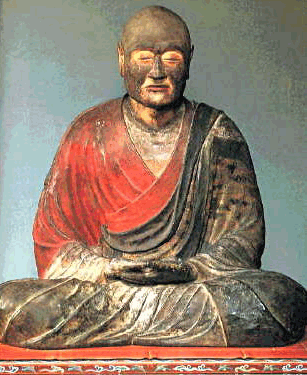
The T’ien T’ai school of Buddhism was initiated by the Chinese monk Zhi-yi, whose efforts to classify the growing body of Buddhist schools and scriptures into a single system of thought, placing it all in an understandable context, characterized the comprehensive nature of T’ien T’ai philosophy throughout its subsequent history. However, it was the work of the monk Chih-i, the third Patriarch of the T’ien T’ai school, which defined the particular T’ien T’ai school philosophy, thus establishing the first Chinese school of Buddhism and giving rise to the phrase Ekayana (“Round School”) teachings. Where Nagarjuna, the principal architect of Madhyamaka philosophy, had set forth the Two Truth’s theory, (i.e. there are two levels of truth in the Dharma, the direct truth and the provisional truth), Chih-i set forth an additional new formulation of reality, the “Perfectly Harmonious Threefold Truth.” Specifically:
All dharmas (phenomena) are empty because they are produced through causation and thus have no self-nature;
They do not have temporary existence either;
Therefore being both empty and temporary is the mean state of affairs for sentient beings.
This syncretic doctrine illustrates the encompassing spirit of T’ien T’ai Buddhism. Another example of this syncretic spirit was the T’ien T’ai affirmation of the value of a wide range of Buddhist Sutras. While affirming the Lotus Sutra as the principal text of the Mahayana school, T’ien T’ai scholars also studied other Sutras, especially the three “Pure Land” texts. Consequently, the T’ien T’ai school endorsed the value of a wide variety of Buddhist spiritual practices, such as meditation, chanting, and various kinds of devotional practices. In this fashion, T’ien T’ai Buddhism developed into a kind of matrix school of Chinese Mahayana thought and practices. It was this “Ekayana” school of Mahayana Buddhism which the Japanese monk known today as Dengyo Daishi, encountered when he visited China in 806 C.E.
2. Dengyo Daishi and the Tendai School
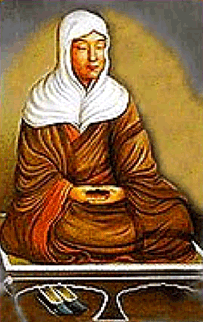 When Dengyo Daishi visited China in 804 CE, Buddhism had already existed in Japan for more than two hundred years. Traditions regarding when Buddhism was first introduced to Japan vary, with some saying it was in 538 CE and others in 552; but all sources agree that the first official Buddhist mission to Japan arrived from the Kingdom of Paekche (later known as Korea), and that the “Kuge” or aristocratic class of the Imperial Court adopted the new religion very quickly. Under the famous patronage of the Prince Shotoku, six of the principal schools of Chinese Buddhism were established in the Imperial city of Nara, Japan, each with their particular doctrines and practices. However, the practices of these “Nara Schools” was limited to their monasteries and Temples, and the court aristocracy who patronized them.
When Dengyo Daishi visited China in 804 CE, Buddhism had already existed in Japan for more than two hundred years. Traditions regarding when Buddhism was first introduced to Japan vary, with some saying it was in 538 CE and others in 552; but all sources agree that the first official Buddhist mission to Japan arrived from the Kingdom of Paekche (later known as Korea), and that the “Kuge” or aristocratic class of the Imperial Court adopted the new religion very quickly. Under the famous patronage of the Prince Shotoku, six of the principal schools of Chinese Buddhism were established in the Imperial city of Nara, Japan, each with their particular doctrines and practices. However, the practices of these “Nara Schools” was limited to their monasteries and Temples, and the court aristocracy who patronized them.
The monk known as Saicho to his contemporaries (posthumously named Dengyo Daishi) was born in 767 in the city of Omi-no-Kuni in ancient Omi province, now in Shiga Prefecture. The son of a pious Buddhist, and probably descended from Chinese immigrants, Saicho was ordained as a priest of the Kegon school in the famous Todai-ji Temple in Nara. However, just three months after being ordained, Saicho left crowded Nara and ascended lonely Mt. Hiei in his native Omi province, and there built a secluded mountain hermitage that, in time, developed into the greatest complex of Buddhist temples in all of Japan. By constant observance of the Dharma and perhaps by interaction with the famous mountain mystics known as the Yamabushi, Saicho consciously purified his sense-faculties in preparation for the work of spreading the Dharma. While on Mt. Hiei, Saicho began studying the works of Chih-i, which had a decisive effect upon his religious orientation. When he eventually began to preach a series of lectures on the meaning of the Lotus Sutra, Saicho attracted the following of the powerful Wake clan, through whom the young monk came to the favorable attention of the Imperial court. When the Imperial court sponsored several promising monks for travel to China for advanced Buddhist studies, Saicho was already the most prominent name among those selected.
It is significant that the convoy of four ships that left Japan in 804 CE for China, included both Saicho (Dengyo Daishi), and Kukai (Kobo Daishi), two of the most revered founders of Japanese Buddhism. Saicho was senior to Kukai in both age and rank, but the young Kukai, destined to become the father of the Shingon school, was more charismatic and thus probably more likeable than the serious Saicho. When a storm struck the convoy and two of the four ships were lost, it was the good fortune of humanity that these two men survived the storm, each reaching China separately, thus ensuring that they would go separate ways in their pursuit of the Dharma. Saicho made his way directly to Mt. T’ien T’ai, and there studied the doctrines and works of Sakyamuni, Nagarjuna and Chih-i, while Kukai went on to study the “esoteric” forms of Buddhism in the city of C’hang-an, eventually returning to Japan to establish the Shingon school of Buddhism.
On Mt. T’ien T’ai, Saicho received the Mahayana or Bodhisattva precepts from the sixth Patriarch of the T’ien T’ai school, as well as advanced Dharma instruction in the various chants, meditations and practices of the many schools of Chinese Buddhism. Carrying hundreds of sutras, treatises and commentaries with him, Saicho then set out to return to Japan. Along the road back, Saicho encountered the Chinese monk Shun-hsiao, a specialist in the esoteric forms of Buddhism, who duly initiated Saicho into the esoteric practices of mudras, mantras and mandalas. Thus, when Saicho finally returned to Japan, he carried with him the complete historical and philosophical legacy of the T’ien T’ai school, as well as knowledge of the esoteric rites of Buddhism, which henceforth became part of the Tendai legacy. It was this form of esoteric T’ien T’ai, for which the Imperial court authorized two new ordinands a year in 806 CE, thus officially marking the establishment of the Tendai school of Buddhism.
Central to Tendai thought as taught by Saicho, is the concept of Original Enlightenment (Hongaku shiso) – the idea that all beings are originally or inherently enlightened, and that liberation is immediately at hand if we can only awaken and cut through the delusions that keep us from seeing our true nature. The importance of this concept on the subsequent development of Japanese Buddhism cannot be overstated, as much of that history was largely in response to Hongaku shiso. This concept, rooted in the central Buddhist belief that everything is interconnected, and expressed in phrases such as “1000 worlds in each moment” (every person affecting everything and everybody at every moment), became seminal to the development of future Buddhism in Japan.
Saicho dedicated the rest of his life to the propagation of the Tendai school and Buddhism in general. Within a few decades, the Tendai school expanded far beyond the confines of Mt. Hiei, and Tendai temples were established as far away as the island of Kyushu in the south, and in the province of Shimotsuke in the north. After his death in 822 CE, Saicho was formally invested with the title of Dengyo Daishi or “Grand Master of the Propagation of the Doctrine.” Because the Tendai school later gave rise to all of the Kamakura-era schools of Japanese Buddhism, the effect of the life of Dengyo Daishi has been to propagate the Dharma in every part of the world where some form of Japanese Buddhism is practiced.
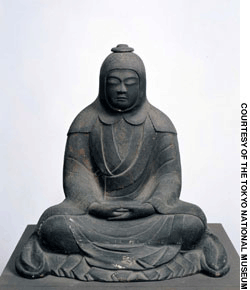
3. The Ascendancy of the Tendai school
The wide variety of teachings and practices of the Tendai-shu gave rise to the term Ekayana (“round school”) teachings. The school reached its greatest influence from the 9th through 12th centuries, under a series of successors to Saicho who expanded the teachings and practices of the Ekayana schoool.
The first Zasu or leader of the sect after Saicho, and Abbot of Hiei-zan Enryakuji (the chief temple of the order), was the monk Ennin. Born into the Mibu clan from the province of Shimotsuke, Ennin’s chief contribution to the development of the Tendai-shu came from a nine-year pilgrimage to China, where he both studied at Mt. T’ien T’ai, as well as received further esoteric teachings and instruction from the same schools where Kukai received the mikkyo rites of the Shingon school. Returning to Japan, Ennin developed Tendai esoteric ritual beyond the legacy received from Saicho, establishing the system of Tendai-specific esoteric rites known today as Taimitsu. Another significant practice which Ennin brought back from China was the chanting of the Nembutsu, the devotional repetition of the phrase, “Homage to Amida Buddha,” as a means of generating merit and ensuring rebirth in the “Western Paradise” of Amida Buddha, where conditions for the attainment of Enlightenment and Nirvana are optimal. The practice of both Taimitsu and Nembutsu thus became salient features of Tendai Buddhism in Japan.
Ennin’s successor was the monk Enchin, a member of the same Wake clan that had supported Saicho so early in his career, and the son of Kukai’s niece. Like Saicho and Ennin before him, Enchin also undertook a pilgrimage to China, again studying at both Mt. T’ien T’ai, as well as esoteric Buddhism in the city of Ch’ang-an. Returning to Japan, Enchin forged important alliances with the ruling Fujiwara clan, thus ensuring the ascendancy of the Tendai school during this period of Japanese history.
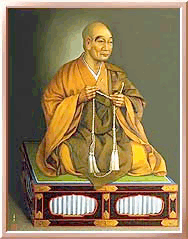
However, power struggles eventually weakened the Tendai-shu. Over time, the Tendai-shu separated into two sub-schools, the so-called “River” school of Ennin’s followers, and the “Mountain” school of Enchin’s followers, each named after the part of Mt. Hiei where these respective schools resided. Also known as the “Sammon” and “Jimon” schools, these two camps eventually resorted to ruinous armed strife in their disputes, as well as in their relations with the court and aristocracy in Kyoto. As the Japanese nation descended into the lawless age that gave rise to the samurai governments of the Shoguns, all of the Japanese Buddhist sects began to maintain units of Sohei or warrior-monks to protect their temples and interests. Partly because of the civil disorder that followed, the Aristocratic and Buddhist elites became less effective at meeting the needs of the common people, thus creating the social conditions for the emergence of new forms of Buddhism
4. Tendai Teachers of the Muromachi & Kamakura Era
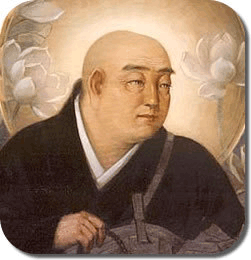
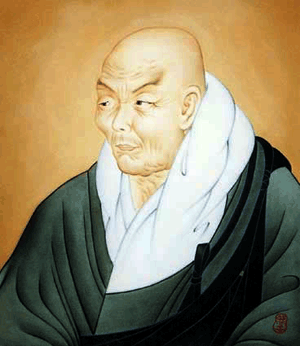
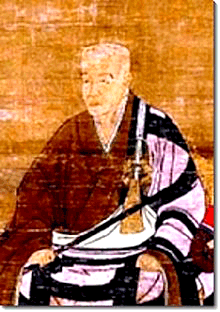
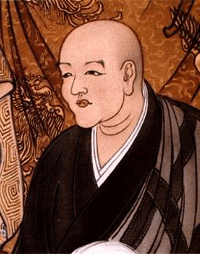
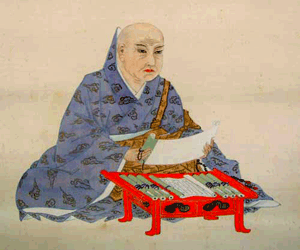
Unfortunately, Nichiren also displayed an unmistakable tendency towards “Triumphalist” behavior and attitudes. Nichiren roundly and frequently denounced all other Buddhist schools and practices as the works of “demons,” especially (but not limited to) the followers of Honen’s Jodo-shu. The Nichiren-shu or Hokekyo-shu (“Lotus Flower School”), also encouraged its followers to criticize those who held Dharma practices other than the Daimoku, or who honored Sutras other than the Lotus Sutra. Not surprisingly, all of the other Buddhist schools, including the Tendai-shu, demanded that the government suppress the Nichiren sect; but when Jodo-shu and Nichiren followers came to blows in Awa in 1264, Nichiren fled for his life to Kamakura, after sustaining a head wound and a broken arm.
Dismayed at his self-fulfilled rejection by the established Buddhist schools, Nichiren prophesied doom upon the Japanese nation. When a letter soon arrived from Kublai Khan, the Mongol Emperor of China, demanding the surrender of Japan, Nichiren instantly was perceived by his followers as a seer and prophet. However, the Shogun’s government was now in no mood to tolerate subversive prophets of doom when the nation was at war, so in 1271 it finally acted against the Nichiren sect, arresting its principal leaders, including Nichiren, as enemies of the nation and disturbers of the peace. Nichiren was led through the streets of Kamakura bound and shackled, and barely escaped being beheaded.
Nichiren’s final years were spent on the island of Sado in exile, but his sect grew and continued to exhibit the spirit of zealous antagonism that Nichiren himself lived his life by. In the twentieth century, the Nichiren lay movement known as Soka Gakkai was denounced by the Nichiren school in a bitter dispute over the legitimacy of each group’s respective Gohonzon (an inscribed object of worship), thus mutually perpetuating the reputation of the Nichiren school for triumphalism, aggressive proselytizing, and conflict.
5. The Tendai School in the Tokugawa and Modern Era
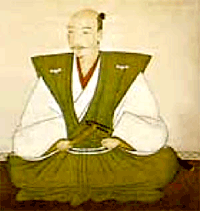
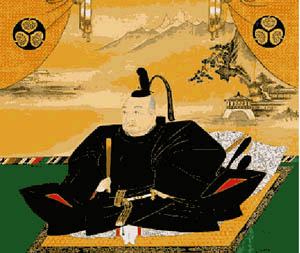
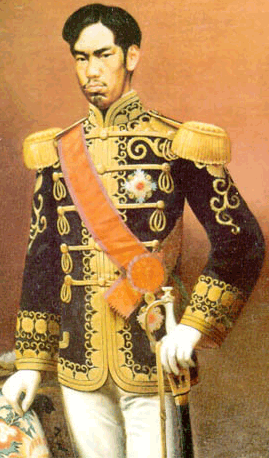 This lethargic state of affairs within Japanese Buddhism lasted over 200 years, until the time of the Meiji Restoration. Because Buddhism had been closely associated with the government of the Bakufu (even if involuntarily), there was a conscious effort by the new Meiji government to undercut the institutional power of the Buddhist schools, and new punitive measures were enacted against them. The old law that required Shinto shrines to affiliate with a Tendai or Shingon Temple was abolished, and State-sponsored Shinto was now promoted as a more suitable vehicle for promoting loyalty to the State and Emperor. Although the Buddhist schools continued to retain the parish system for the laity, government sponsorship of the temples and parishes was abolished. Furthermore, the Buddhist practice of celibacy for monks was henceforth prohibited, and monks were obliged to take wives or surrender their ordination. By this, the government intended to discredit the Buddhist clergy among the people; but the measure backfired, as it was soon realized that married priests became more (not less) involved in the life of the laity, leading to the creation of several lay-believers associations within the established Buddhist sects.
This lethargic state of affairs within Japanese Buddhism lasted over 200 years, until the time of the Meiji Restoration. Because Buddhism had been closely associated with the government of the Bakufu (even if involuntarily), there was a conscious effort by the new Meiji government to undercut the institutional power of the Buddhist schools, and new punitive measures were enacted against them. The old law that required Shinto shrines to affiliate with a Tendai or Shingon Temple was abolished, and State-sponsored Shinto was now promoted as a more suitable vehicle for promoting loyalty to the State and Emperor. Although the Buddhist schools continued to retain the parish system for the laity, government sponsorship of the temples and parishes was abolished. Furthermore, the Buddhist practice of celibacy for monks was henceforth prohibited, and monks were obliged to take wives or surrender their ordination. By this, the government intended to discredit the Buddhist clergy among the people; but the measure backfired, as it was soon realized that married priests became more (not less) involved in the life of the laity, leading to the creation of several lay-believers associations within the established Buddhist sects.
With the exception of the Zen schools and the Nichiren sect, most of the Buddhist schools, including the Tendai shu, avoided being drawn into the excesses of Japanese nationalism during the war years. After the war, the rise of Buddhist lay believers associations helped revitalize Japanese Buddhism. The various schools of Japanese Buddhism began to expand overseas and, for the first time, accept non-Japanese members. Today the Tendai shu continues to maintain more than 2,500 temples and several thousand priests across Japan, and hundreds of thousands of lay Tendai Buddhists cultivate one of the diverse practices of the Tendai school. With the establishment of overseas Tendai Sangha (congregations) and missions, the teachings of the ancient masters Chih-i and Dengyo Daishi are now regularly studied and practiced by many non-Japanese people around the world. Tolerant of all forms of Buddhist practice, and conversant with all of them, the Tendai-shu is superbly equipped to serve as Dharma teacher to all nations, and ease human suffering by helping people find the right form of Buddhist practice for them, as Sakyamuni, Chih-i and Dengyo Daishi did so long ago.
BIBLIOGRAPHY – TENDAI BUDDHISM
For more information on the history of Tendai Buddhism,
please see the following resources:
Adolphson, M.S. (2000) The Gates of Power: Monks, Courtiers and Warriors in Premodern Japan. Honolulu; University of Hawai’i press.
Anesaki, M. (1963) History of Japanese Religion: With Special Reference to the Social and Moral Life of the Nation. Rutland Vermont; Charles E. Tuttle Company.
Chappel, D. (1983) Tendai Shikyogi: An Outline of the T’ien-t’ai Fourfold Teachings. Tokyo; Daiichi Shobo.
Chappel, D. (1976) Introduction to the T’ien-t’ai-ssu-chiao-i. The Eastern Buddhist, New Series Vol. IV, No. 1 May.
Chih-I (1923) On the Method of Practicing Concentration and Contemplation (Trans. by) K. Okakura, Cambridge; Harvard Theological Review. Vol XVI; 2, pp 72-87
Covell, Stephen G. (2005) Japanese Temple Buddhism. Contemporary Buddhism. Honolulu: University of Hawaii Press.
Donner N, and DB Stevenson (1993) The Great Calming and Contemplation: A study and annotated Translation of the First Chapter of Chi-i’s Mo-ho chih-kuan. A Kuroda Institute Book. Honolulu; University of Hawaii Press.
Grappard, A. (1998) Keiranshuyoshu: A different Perspective on Mt. Hiei in the Medieval Period. (in) Re-Visioning “Kamakura” Buddhism. A Kuroda Institute Book. Studies in East Asian Buddhism II. Honolulu; University of Hawaii Press.
Groner, P. (1984) Saicho: The Establishment of the Japanese Tendai School. Berkeley; Berkeley Buddhist Studies Series.
Groner, P. (2002) Ryogen and Mount Hiei: Japanese Tendai in the Tenth Century. Studies in East Asian Buddhism 15. A Kuroda Institute Book. Honolulu; University of Hawaii Press.
Hur, N (2000) Prayer and Play in Late Tokugawa Japan. Harvard East Asian Monograph 185. Cambridge; Published by Harvard University Asia Center and Distributed by Harvard University Press.
Kashiwahara Y. and K. Sonoda (1994) Shapers of Japanese Buddhism. Tokyo; Kosei Publishing Co.
Kasahara, Kazuo, (2001) A History of Japanese Religion, Kosei Publishing Company, Tokyo.
Magnin, P.(1979) La vie et l’oeuvre de Huisi (515-577) (Les Origins de lan secte bouddhique chinoise du Tiantai). Paris; École Francaise d’Extrême-Orient. (In French– Describes the origins of T’ien-t’ai Buddhist teachings and practices).
Matsunaga, A and D Matsunaga (1996) Foundations of Japanese Buddhism: Volume I: The Aristocratic Age Revised Edition no. 05. Los Angeles; Buddhist Books International.
Matsunaga, A and D Matsunaga (1974) Foundations of Japanese Buddhism: Volume II: The Mass Movement (Kamakura & Muromachi Periods). Los Angeles; Buddhist Books International.
Saso, Michael (1991) Homa Rites and Mandala Meditation in Tendai Buddhism. New Delhi; Aditya Prakashan.
Stevens, John (1988) The Marathon Monks of Mt. Hiei. Boston; Shambhala Press.
Stevenson, Daniel (1986) The Four Kinds of Samadhi in Early T’ien-T’ai Buddhism (in) Traditions of Meditation in Chinese Buddhism, Gregory, Peter (ed). Honolulu; University of Hawaii Press.
Stone, J. (1999) Original Enlightenment and the Transformation of Medieval Japanese Buddhism. A Kuroda Institute Book. Studies in East Asian Buddhism 12. Honolulu; University of Hawai’i Press.
Swanson, Paul (1989) Foundations of T’ien-T’ai Philosophy: The Foundation of the Two Truths Theory in Chinese Buddhism. Berkeley; Asian Humanities Press.
Welch, H (1967) The Practice of Chinese Buddhism: 1900 – 1950. Cambridge; Harvard University Press.
Yu-Kwan, NG (1993) T’ien-T’ai Buddhism and Early Madyamika. Honolulu; Tendai Institute of Hawaii, University of Hawaii Press.
Ziporyn, Brook (2004) Being and Ambiguity: Philosophical Experiments with Tientai Buddhism. Illinois, USA, Open Court.
Ziporyn, Brook (2000) Evil and/or/as the Good: Omnicentrism, Intersubjectivity and Value Paradox in Tiantai Buddhist Thought- Cambridge, Harvard University Press.
– Source : Tendai.org





Comments are closed.